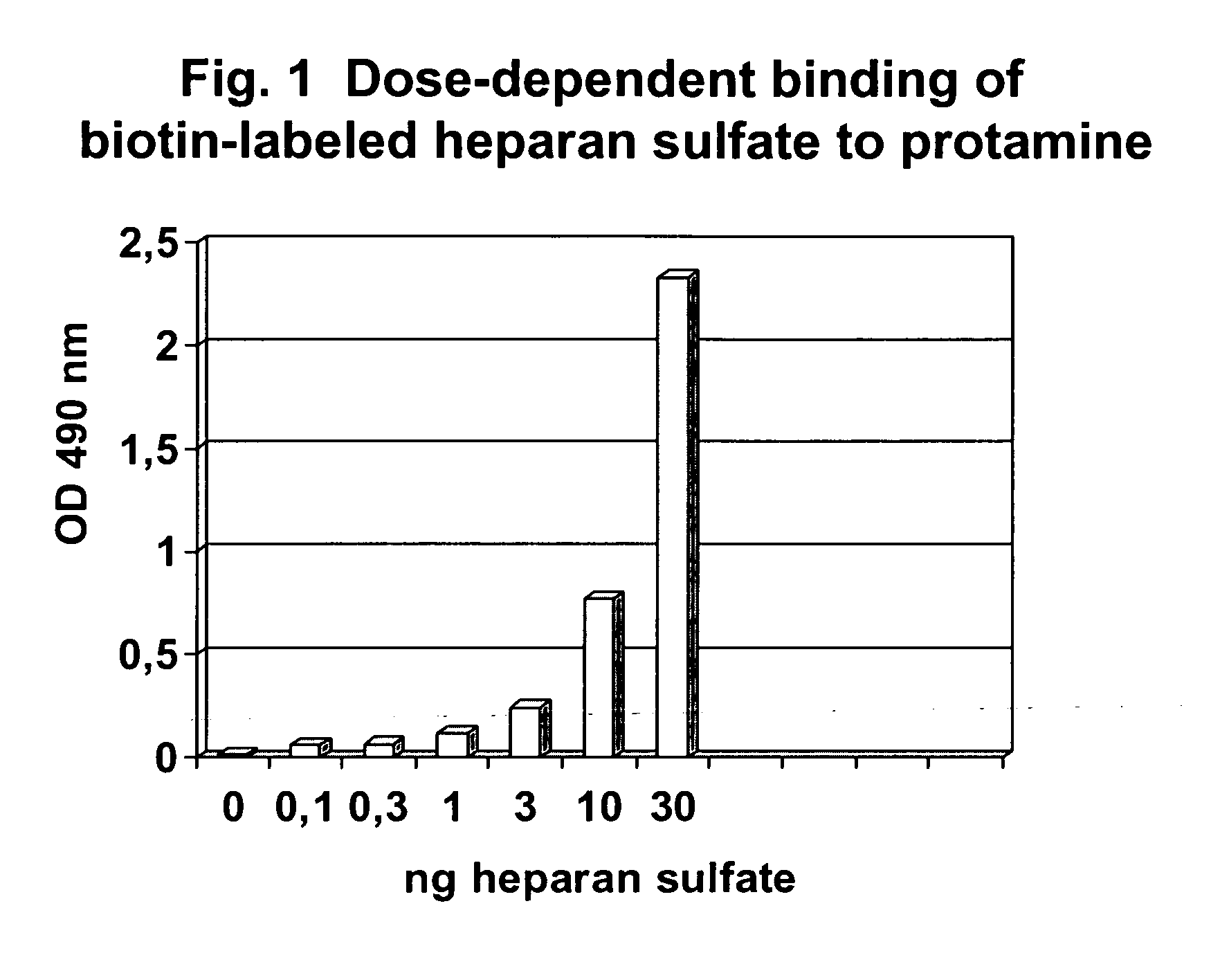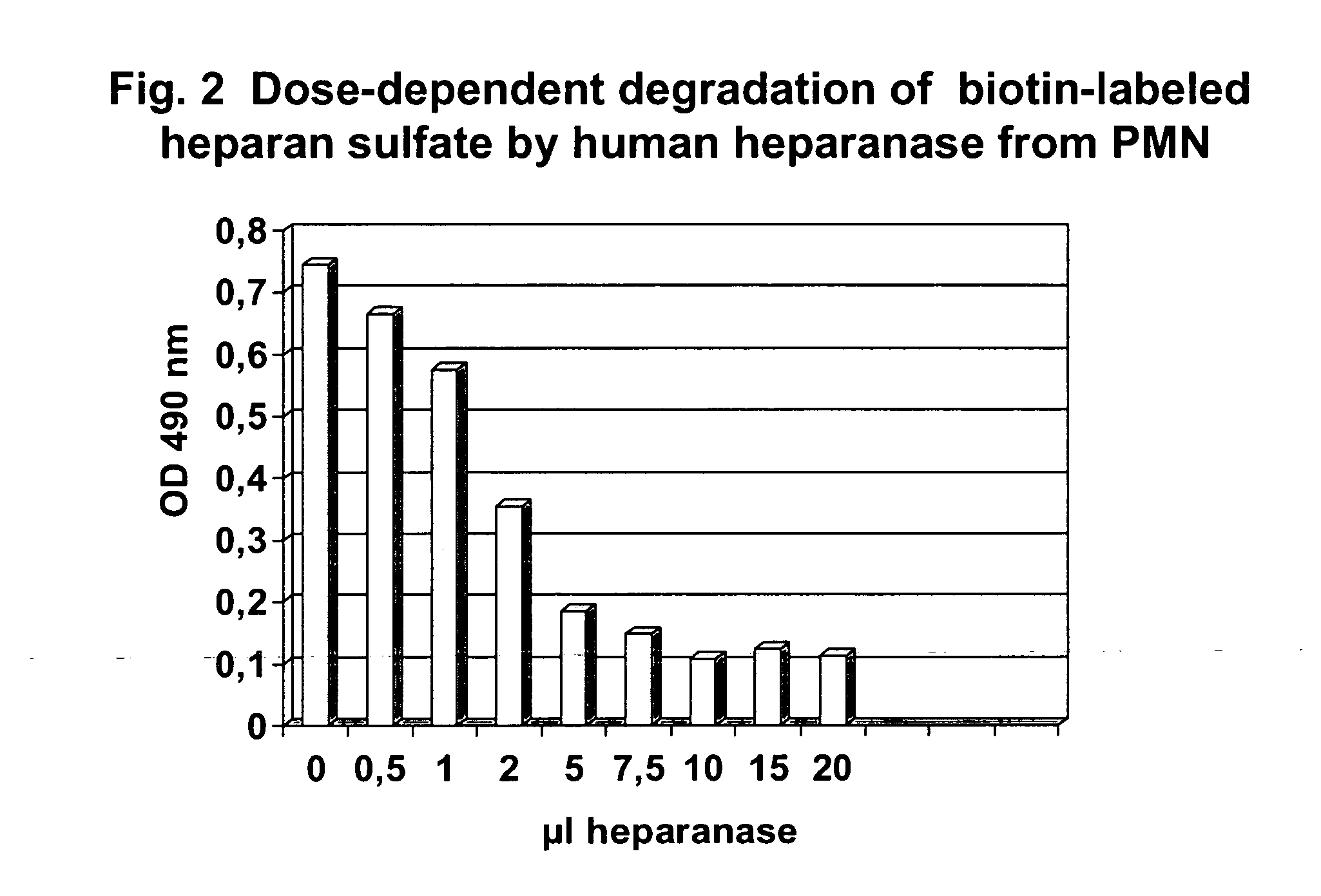Method for determining endoglycosidase (heparanase) enzyme activity
a technology of endoglycosidase and enzyme activity, applied in the field of method for determining endoglycosidase enzyme activity, can solve the problems of inability to perform the method has all the problems and limitations associated with the use of radioelements, and the method is not suitable for routine testing or high throughput screening
- Summary
- Abstract
- Description
- Claims
- Application Information
AI Technical Summary
Benefits of technology
Problems solved by technology
Method used
Image
Examples
example 1
[0114]Preparation of a-HS-Biotin Substrate
[0115]Reagents Used:[0116]Solution of HS (Sigma H9902) at 5 mg / ml: 5 mg HS +1 ml PBS (Gibco).[0117]Solution of Sulfo-NHS-LC-Biotin (EZ-Link® Sulfo-NHS-LC-Biotin) at 20 mM:[0118]11 mg Sulfo-NHS-LC-Biotin (Pierce) +1 ml PBS (Gibco)
[0119]Biotin Labeling[0120]1 ml of a solution of HS at 5 mg / ml (Sigma) are mixed with 0.1 ml of 20 mM Sulfo-NHS-LC-Biotin. The mixture is incubated for 18 h at 37° C. Excess biotin is removed using a 5 ml Zeba™ Desalt Spin Column (Pierce), equilibrated with PBS. By this, 1 ml of solution containing the biotinylated HS, hereinafter referred to as biotin-HS, was obtained.
example 2
Determination of the Final Molar Ratios
[0121]Assaying the Biotin:
[0122]The biotin concentration is measured using a photometric assay based on the competition of biotin-HS and HABA (4′-hydroxyazobenzene-2-carboxylic acid) for binding to avidin. Absorbance of the HABA / avidin complex is measured at 500 nm. Subsequently, biotin-HS is added and the decrease of absorbance is recorded. Known amounts of biotin-labeled POD are used as standard to calculate the molar ratio of biotin and HS.
example 3
Testing the Binding of Biotin-labeled HS to a Protamine-coated Solid Phase
[0123]Reagents Used:[0124]Biotin-labeled HS (see above, example 1)[0125]Protamine sulfate, from herring, grade III, Sigma P4505[0126]Avidin-POD (Sigma A 3151)[0127]PBS / 0.01% Tween-20[0128]OPD (Dako S 204530)
[0129]A solid phase, for example a microtiterplate, is coated with protamine by incubation of 100 μl / well of a 0.003% solution of protamine sulfate at 37° C. for 24 hours. Thereafter, plates were washed 3 times with A dest. and stored in the dark.
[0130]The binding capacity of the solid phase, e.g. the wells of the microplate, was analyzed by incubation of increasing amounts of biotin-labeled HS (0.1-100 ng / ml) for 60 min at room temperature
[0131]Plates were washed 3 times with buffer (PBS / 0.01% Tween 20) and Avidin-POD (1 μg / ml in PBS / 5% BSA) was added.
[0132]After 15 min plates were washed 5 times with citrate / phosphate-buffer (pH 6.2; 34.7 mM citric acid / 66.7 mM Na2HPO4) and 100 μl OPD-solution (0,667 mg / m...
PUM
| Property | Measurement | Unit |
|---|---|---|
| Molecular weight | aaaaa | aaaaa |
| Fluorescence | aaaaa | aaaaa |
| Chemiluminescence | aaaaa | aaaaa |
Abstract
Description
Claims
Application Information
 Login to View More
Login to View More - R&D
- Intellectual Property
- Life Sciences
- Materials
- Tech Scout
- Unparalleled Data Quality
- Higher Quality Content
- 60% Fewer Hallucinations
Browse by: Latest US Patents, China's latest patents, Technical Efficacy Thesaurus, Application Domain, Technology Topic, Popular Technical Reports.
© 2025 PatSnap. All rights reserved.Legal|Privacy policy|Modern Slavery Act Transparency Statement|Sitemap|About US| Contact US: help@patsnap.com



